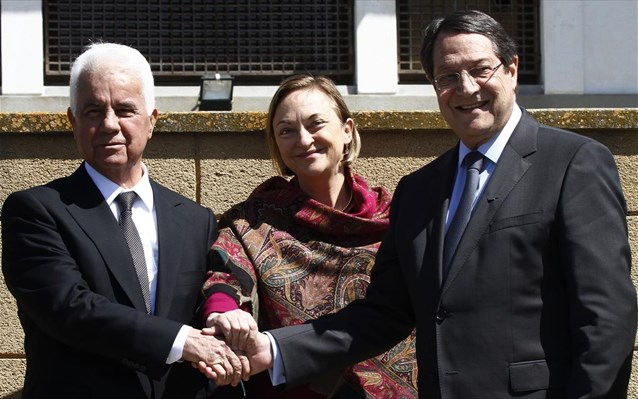Pictures: www.naftemporiki.gr
In a study commissioned by the PRIO Cyprus Centre, economists Fiona Mullen, Alexandros Apostolides, and Mustafa Besim, claim that resolving the Cypriot issue may generate an annual income of 12,000 euros per capita and about 20 billion euros to the GDP of Cyprus in the course of 20 years.
These comments refer to a possible scenario resulting from a unification of the island based on a bi-zonal, bi-communal federation as negotiated by Cypriot President Nicos Anastasiades and Turkish Cypriot leader, Dervis Eroglu.

Cypriot President Nicos Anastasiades (on the right), Turkish Cypriot leader, Dervis Eroglu, and the Special Representative of UN Secretary General in Cyprus, Liza Buttenheim
The three economists conducted their study, assuming that the first year of the unification will be 2016, and gave their analyses and assessments about the overall development of the Cypriot economy and economic trends in economic branches over the following 20 years. According to their forecasts, the average rate of GDP growth in these 20 years will be 2.8 per cent.
The study also points out that over the period there has been no significant increase of total factor productivity (TFP) in either of the communities, while TFP is an indicator of long-term development prospects in advanced economies.
‘The low TFP level is a warning signal that the unhealthy economic development and the high unemployment rates on the island will continue for a long time. Therefore, both parties would benefit from a ‘peace dividend’ which will be generated by two sources: the benefits of opening the 74-million-people Turkish market to Cypriot Greeks, and the 500-million-people EU market to Cypriot Turks’, the economists observe.
‘The Peace Dividend’
At constant 2012 prices, the all-island GDP would rise from nearly 20 billion euros in 2016 to nearly 45 billion euros in 2035, in contrast to nearly 25 billion euros if there were no unification.
Otherwise stated, the dividend generated over the 20-year period may amount to just under 20 billion euros.
Average annual dividend might exceed 2 billion euros in the first five years following the unification; it would increase to 5 billion euros in the first 20 years, and exceed 10 billion euros over the first 20 years.
As a result of the peace agreement, GDP per capita would increase from 15,500 euros in 2016 to 28,500 euros in 2035, in contrast to just 16,500 euros if the unification project failed. Annual income based on 2012 prices would thus rise by 12,000 euros.
Average annual growth will reach 4.5 per cent over the next 20 years, compared to just 1.6 per cent without the unification; growth will peak over the first 10 years.
Personal revenue in the Turkish Cypriot community would reach 91 per cent of the level in the Greek Cypriot community in these 20 years, compared to about 60 per cent today.
The study also describes the beneficial impact which the unification would have on industrial branches and comments on development prospects for tourism and hospitality, construction, commerce, transportation, services, and education.
‘Easier route for natural gas through Turkey’
The economists are confident that a gas pipeline to Turkey will be the easier route for exporting natural gas from Cypriot company AOZ. ‘A gas pipeline to Turkey will generate joint investment which will be higher by 1.3 million euros and, above all, revenue from natural gas will be generated sooner than in the case of no unification’, the study observes. It also adds that building a gas pipeline will be profitable even at today’s guaranteed quantities from the Aphrodite gas field.
Good returns are also expected from the investment made for the unification, the most vivid example being the revival of Ammochostos, for which the three economists predict an environmental model of reconstruction. ‘An ambitious idea like a modern and environmentally friendly city spreading over the whole of Ammochostos could bring in an investment of nearly 15 billion euros’, emphasize the economists.